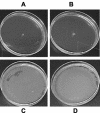Extracellular proteolytic activity plays a central role in swarming motility in Bacillus subtilis
- PMID: 15205417
- PMCID: PMC421602
- DOI: 10.1128/JB.186.13.4159-4167.2004
Extracellular proteolytic activity plays a central role in swarming motility in Bacillus subtilis
Abstract
Natural isolates of Bacillus subtilis exhibit a robust multicellular behavior known as swarming. A form of motility, swarming is characterized by a rapid, coordinated progression of a bacterial population across a surface. As a collective bacterial process, swarming is often associated with biofilm formation and has been linked to virulence factor expression in pathogenic bacteria. While the swarming phenotype has been well documented for Bacillus species, an understanding of the molecular mechanisms responsible remains largely isolated to gram-negative bacteria. To better understand how swarming is controlled in members of the genus Bacillus, we investigated the effect of a series of gene deletions on swarm motility. Our analysis revealed that a strain deficient for the production of surfactin and extracellular proteolytic activity did not swarm or form biofilm. While it is known that surfactin, a lipoprotein surfactant, functions in swarming motility by reducing surface tension, this is the first report demonstrating that general extracellular protease activity also has an important function. These results not only help to define the factors involved in eliciting swarm migration but support the idea that swarming and biofilm formation may have overlapping control mechanisms.
Figures





References
-
- Allison, C., H. C. Lai, and C. Hughes. 1992. Co-ordinate expression of virulence genes during swarm-cell differentiation and population migration of Proteus mirabilis. Mol. Microbiol. 6:1583-1591. - PubMed
-
- Costerton, J. W., K. J. Cheng, G. G. Geesey, T. I. Ladd, J. C. Nickel, M. Dasgupta, and T. J. Marrie. 1987. Bacterial biofilms in nature and disease. Annu. Rev. Microbiol. 41:435-464. - PubMed
-
- Deziel, E., F. Lepine, S. Milot, and R. Villemur. 2003. rhlA is required for the production of a novel biosurfactant promoting swarming motility in Pseudomonas aeruginosa: 3-(3-hydroxyalkanoyloxy)alkanoic acids (HAAs), the precursors of rhamnolipids. Microbiology 149:2005-2013. - PubMed
MeSH terms
Substances
LinkOut - more resources
Full Text Sources
Other Literature Sources
Molecular Biology Databases
Research Materials

